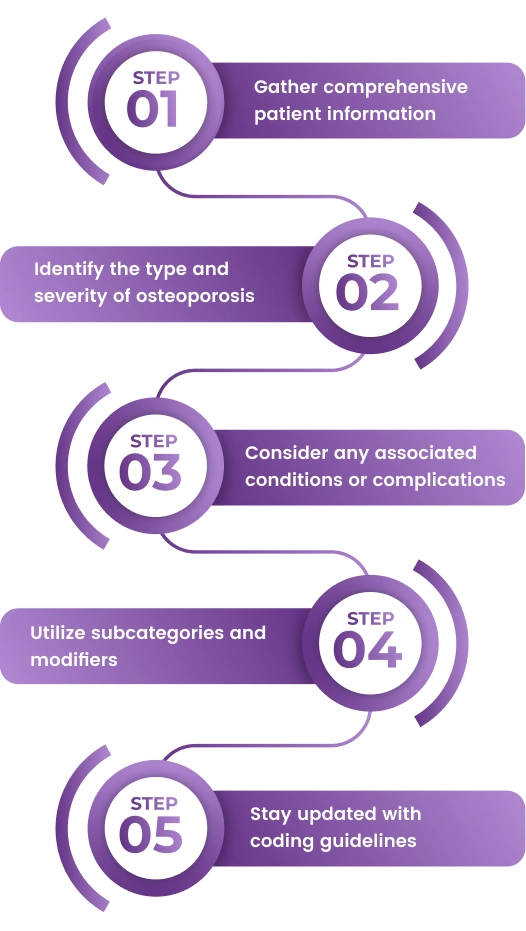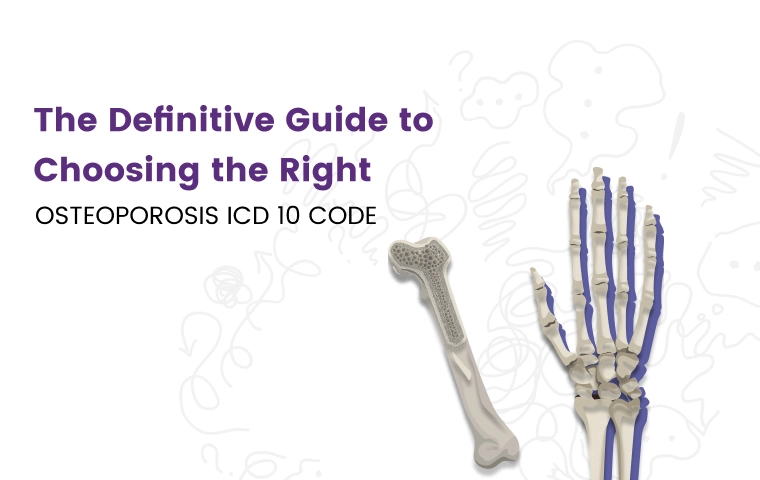Medical coders nowadays feel lost in the swamps of Coding. When coding for diseases such as Osteoporosis, it is important to be aware of the accurate ICD-10 Code for osteoporosis. So now the question here arises how you are going to use find the right osteoporosis icd 10 code? You don't need to go anywhere, in this blog we will provide you with key points that can help you to find the right ICD-10 code. just stay with us till the last.
What is Osteoporosis?
Osteoporosis is defined as a skeletal disorder characterized by compromised bone strength leading to an increased risk of fracture. It is sometimes called an “invisible” disease because it often has no symptoms until a fracture occurs. Osteoporosis is seen most commonly in elderly women, although it can occur in men and younger individuals as well.
Risk Factors Associated with Osteoporosis
Understanding these risk factors is crucial for prevention, early detection, and effective management of this condition. While aging is a primary risk factor, several other factors can aid in the development of osteoporosis. Some of the most common factors that can impact the bone health are:
- Age
- Gender
- Family History
- Hormonal Factors
- Low Bone Density
Now you may have got an idea about what osteoporosis is and the risk factors that are an aid to it. Let's find out what you are going to code for osteoporosis.
What is the billable osteoporosis ICD 10 code?
The billable ICD-10 code for osteoporosis is M81.0. This code specifically represents Postmenopausal osteoporosis with current pathological fracture.
Common Osteoporosis ICD 10 Codes
Here are some commonly used ICD 10 codes related to osteoporosis:

- M81 - Osteoporosis without current pathological fracture
- M81.6 - Localized Osteoporosis
- M82 - Osteoporosis in diseases classified elsewhere
- M85 - Other disorders of bone density and structure
- M86 - Other osteomyelitis
- M90 - Osteopathy in diseases classified elsewhere
- Z87 - Personal history of osteoporosis
How to Assign Osteoporosis ICD 10 Codes Correctly
Assigning the correct ICD 10 codes for osteoporosis is crucial for accurate documentation and billing.
Here are some key steps to ensure proper coding:

Gather comprehensive patient information:
Collect all relevant details about the patient's medical history, diagnostic tests, imaging results, and any associated conditions. This information will help in selecting the most appropriate ICD 10 code.
Identify the type and severity of osteoporosis:
Determine whether the osteoporosis is associated with a current pathological fracture, if it is without a fracture, or if it is related to another underlying condition. This will guide you in choosing the correct code from the M80-M90 range.
Consider any associated conditions or complications:
If the patient has osteoporosis due to a specific disease or condition, such as osteoporosis associated with rheumatoid arthritis, select the appropriate code from the M82 range.
Utilize subcategories and modifiers:
Within the main code categories, there are subcategories and modifiers that provide additional specificity. Pay attention to these modifiers and use them when necessary to accurately reflect the patient's condition.
Stay updated with coding guidelines:
Regularly review the official ICD 10 coding guidelines to ensure compliance with the latest revisions. Familiarize yourself with any new codes, revisions, or coding conventions related to osteoporosis.
By following these steps and staying informed about coding guidelines, you can assign osteoporosis ICD 10 codes correctly, ensuring accurate documentation and billing for osteoporosis-related services.
Frequently Encountered Challenges with Osteoporosis ICD 10 Coding
While coding for osteoporosis using ICD 10 codes is generally straightforward, there are certain challenges that healthcare professionals may encounter. Here are a few commonly faced issues:
> Accurate coding requires detailed documentation. Incomplete or vague information regarding the type of fracture, location, or associated conditions can make it difficult to select the appropriate ICD 10 code. Healthcare providers should collaborate with clinicians and specialists to ensure comprehensive documentation.
> Osteopenia, a condition characterized by low bone density but not meeting the diagnostic threshold for osteoporosis, has its own specific codes (e.g., M85.8). It is essential to differentiate between osteoporosis and osteopenia to assign the correct code.
> Inaccurate coding can occur when healthcare professionals are unfamiliar with the specific guidelines related to osteoporosis coding. Regular training and staying updated with coding resources can help overcome this challenge.
> Some patients with osteoporosis may have multiple fractures or complications related to their condition. These cases may require the use of additional codes or modifiers to capture the complexity of the patient's condition accurately.
To overcome these challenges, healthcare professionals should invest in continuous education, consult coding resources, and foster open communication with the healthcare team to ensure accurate and detailed documentation, leading to appropriate coding for osteoporosis.
How We Find the Accurate ICD 10 Codes?
Our certified medical coders have reviewed the latest information generated by the World Health Organization (WHO) regarding the 10th revision of the International Classification of Diseases (ICD) system. The codes comply with the regulations set forth by the Health Insurance Portability and Accountability Act (HIPAA).
Final Words
Osteoporosis ICD 10 codes are instrumental in the diagnosis, treatment, and billing of osteoporosis in the American healthcare system. These codes provide a standardized way of documenting and categorizing the disease, ensuring accurate communication between healthcare providers, insurance companies, and other stakeholders. By understanding the significance of these codes, healthcare professionals can effectively manage osteoporosis and provide optimal care to their patients.
Remember, proper coding is essential for accurate diagnosis, appropriate treatment, and seamless reimbursement. Stay informed with HMS USA LLC about the latest updates to the ICD 10 codes to ensure compliance and effective healthcare delivery.
You can find a vast array of resources regarding the ICD coding systems, specifically tailored to various medical procedures enabling you to navigate the complex landscape of medical coding and reimbursement with confidence and proficiency.
ABOUT AUTHOR

Neil Wagner
As a blog writer with years of experience in the healthcare industry, I have got what it takes to write well researched content that adds value for the audience. I am a curious individual by nature, driven by passion and I translate that into my writings. I aspire to be among the leading content writers in the world.
